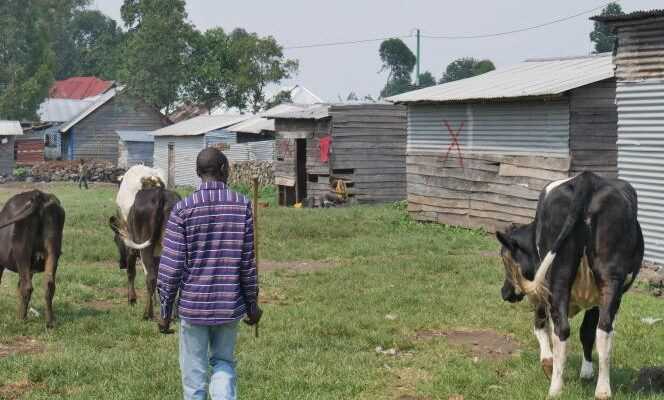To not miss anything on African news, subscribe to the newsletter of World Africa from this link. Every Saturday at 6 a.m., find a week of current events and debates treated by the editorial staff of World Africa.
At the foot of the Nyiragongo volcano, in the eastern Democratic Republic of the Congo (DRC), three cows are struggling to find grass among the dried lava pebbles. “We are threatened”, worries Jean-Baptiste Maliru looking at the top of the cone. The various flows, in particular that of May 22, when the volcano erupted, devastated “70% of our land”, continues this peasant. In Munigi, a village on the outskirts of Goma, in the province of North Kivu, cattle have almost disappeared from the landscape. Today, unemployment threatens the 350 families who live on livestock.
The burial of the fields is not the only consequence of the events of the month of May for Jean-Baptiste Maliru and his family. Shepherds’ boots and sticks piled up on the doormat, the herders of the territory of Nyiragongo, one of the administrative entities of North Kivu, hold a meeting in their president’s living room. Head down, Habawézé Tabaro is indignant: “If all our spaces are sold, what are we going to live with? ”
After the eruption, a private initiative launched by the former first lady, Marie-Olive Lembé Kabila, awakened a dormant land conflict. The wife of former President Joseph Kabila offered 100 hectares to the victims of the volcano so that they can rebuild homes. Land hitherto left fallow and which she claims to have bought ” few years ago “, as she explained just after the eruption to the local press. However, their acquisition is considered fraudulent by breeders.
In 2017, marches had already been organized to protest against the purchase of land by politicians, soldiers and other influential figures.
“The biggest spoiler is the state! “
According to civil society, the plots, distributed in October to more than 200 households, belong to collective spaces governed by traditional authorities. These fields have been reserved for cattle grazing since the 1940s, as stated in colonial administration documents provided by pastoralists. However, during the last decade, nearly 45% of these community enclosures have been sold to individuals, without any transparency in the procedures, estimates the village committee. “We solve disaster victims’ problems, but we create new ones for us. Without grass, no cows, therefore no meat and no milk! “exclaims Jean-Baptiste Maliru.
This land conflict is far from being the only one in the region and more broadly in the DRC. Across the country, the same land grabbing scenario is repeated. So much so that in March 2019, the Congolese state set up a commission called “Etienne-Tshisekedi” (the father of the current president, Félix Tshisekedi), in charge of identifying all the cases where citizens were dislodged. by force or deprived of their plots, in order to put an end to these spoliations. Yet this scourge persists.
“The biggest spoiler is the state itself! “, accuses Jean-Claude Mambo Kawaya, president of the civil society of the territory of Nyiragongo, a group of citizen associations. For more than five years, he has been examining the complaints of his fellow citizens. But he never won a single fight. Despite the scarcity of agricultural land, “Politicians, generals or wealthy economic operators” still manage to get hold of it. “And if someone disputes the ownership of these newcomers, they manage to provide papers that come from the provincial authorities or from Kinshasa”, explains the activist in his office built of wooden planks, lit with a torch for lack of electricity.
More than 1,000 inhabitants per square kilometer
There are two opposing legal systems: one, modern, is based on official documents from central or local administrations; the other, customary, is based on the words of the communities. As a result, legal remedies are unsuccessful, even when the clashes are deadly. “They are part of our daily life”, explains Commissioner Jean-Marie Malossa. Since becoming deputy administrator of the territory, he has stepped up the security of his police station. With his Kalashnikov behind him and his handgun placed near his cap, he recognizes that some plots have been usurped. “But we have launched a procedure to list and recover them”, he assures.
In the meantime, the slow disappearance of land could jeopardize the professions of breeder and farmer. And hence increase insecurity in the area. “Without jobs, the young unemployed could also form themselves into rebel militias”, warns one of the deans of the village of Munigi. The violence exerted by armed groups in the east of the country for more than twenty years has pushed hundreds of thousands of people to flee their villages and to resettle near the city of Goma. In 2016, there were more than 1,000 inhabitants per square kilometer, a figure more than twenty times higher than the national average, according to an official document from the provincial government of North Kivu.
Demographic pressure continues to increase in this district wedged between Rwanda to the east, the Virunga national park to the west and the volcano to the north. The Nyiragongo is however one of the most dangerous in Africa and could again surprise the population with a new eruption, explains Albert Muhindo, the director of the Volcanological Observatory of Goma: “When we live here we are forced to accept to be under that kind of pressure. “
